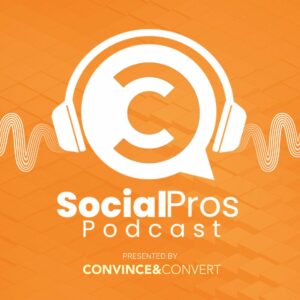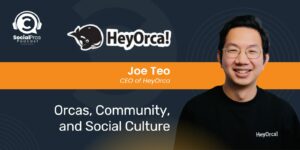Hosted By
About Social Pros Podcast:
Social Pros is one of the longest-running marketing podcasts in existence (10 YEARS and counting), and was recently recognized as the #1 Audio/Podcast Series by the Content Marketing Awards.
Our purpose? Making sure that we speak to real people doing real work in social media.
Listeners get inside stories and behind-the-scenes secrets about how teams at companies like Google, Reddit, Glossier, Zillow, Lyft, Marvel, and dozens more, staff, operate, and measure their social media programs. With 600+ episodes, the Social Pros Podcast brings the humanity of social media to the forefront, while providing incredibly useful marketing strategies that listeners can immediately implement.
Follow Social Pros on LinkedIn.
To inquire about becoming a guest or show sponsor, please email our Executive Producer, Leanna Pham, at leanna@convinceandconvert.com.
Apple Podcast Reviews:
The Social Pros podcast has quickly become a favorite in my feed! I'm consistently impressed by the engaging conversations, insightful content, and actionable ideas. I truly learn something every time I listen!
@Arlie KThis is absolutely an awesome listen for anyone in communications or social media!!
@Will31CThis podcast has become one of my staple weekly podcasts for learning about marketing! Love the conversations that they have and it's always enjoyable and educational!
@Simonstone95Love the podcast - informative, in depth and spot on for any business size.
@MissTriathlonThis is Episode 1 of the Social Pros Podcast : Real People Doing Real Work in Social Media. This episode features Taulbee Jackson, CEO of Raidious, the social and content agency that built and is managing the Super Bowl Social Media Command Center. Read on for insights from Taulbee, our “Work It Out” advice segment, […]
 This is Episode 1 of the Social Pros Podcast : Real People Doing Real Work in Social Media. This episode features Taulbee Jackson, CEO of Raidious, the social and content agency that built and is managing the Super Bowl Social Media Command Center. Read on for insights from Taulbee, our “Work It Out” advice segment, and Eric’s Social Media Stat of the Week (this week: The Edelman Trust Barometer).
This is Episode 1 of the Social Pros Podcast : Real People Doing Real Work in Social Media. This episode features Taulbee Jackson, CEO of Raidious, the social and content agency that built and is managing the Super Bowl Social Media Command Center. Read on for insights from Taulbee, our “Work It Out” advice segment, and Eric’s Social Media Stat of the Week (this week: The Edelman Trust Barometer).
Next week’s guest is Scott Monty from Ford Motor Company.
Listen Now
Click the play button to listen here:
[podcast]http://socialpros.podbean.com/mf/web/yyue7/SocialProsEpisode1.mp3[/podcast]
Download the audio file: http://socialpros.podbean.com/mf/web/yyue7/SocialProsEpisode1.mp3
The RSS feed is: http://feeds.feedburner.com/socialprospodcast
Find us on iTunes too!
Please Support Our Sponsors
Huge thanks to Argyle Social for their presenting sponsorship, as well as Infusionsoft and Jim Kukral at DigitalBookLaunch. We use Argyle Social for our social engagement; we use Infusionsoft for our email; and Jim is our guest host for the podcast and a smart guy)
Social Pros Transcript For Your Reading Enjoyment
Transcription services from our friends at Speechpad.com
Jay: Well, here we are at long last. It is the debut, the first ever, the maiden voyage of the Social Pros podcast. I am your host, Jay Baer from Convince & Convert, joined virtually alongside by my trusty sidekick, Eric Boggs, the CEO of Argyle Social. Eric, what is going on?
Eric: Not too much, Jay. Excited to get this rocking.
Jay: We are getting it rocking thanks to the support of Argyle Social for bringing the Social Pros podcast to all of you out there. Other sponsors we should recognize are our good friends at Infusionsoft, who we use to send all of our email and such, and my good friend Jim Kukral, who runs DigitalBookLaunch.com and is also going to be our fill-in host when I am ill or can no longer abide Eric Boggs.
We have an amazing guest. It’s remarkable that this is our very first time doing this and we have a guest of this, not only quality, but timeliness. Our friend Taulbee Jackson, the President and CEO of Raidious in Indianapolis, Indiana, is going to join us a little bit later on the show.
Taulbee’s company put together and is staffing, right now as we discuss this, the Super Bowl Social Media Command Center. They’ve got 652 Macs lined up looking at every single Tweet and Facebook post and Instagram photo associated with the Super Bowl, which is happening just an hour from where I stand at this very minute. The man has a lot on his plate, and he set it aside temporarily to join us on Social Pros. We are very fortunate and looking forward to talking to Taulbee in just a couple of minutes.
Eric: He’s a busy guy. I know he’s got a good story to tell. I can’t wait.
Jay’s Thought of the Week
Jay: Absolutely. We are going to start off the show, as we customarily will, with my thought of the week. Eric, I’m sure you saw this news as well, being in the social media software space yourselves. I don’t get this whole thing with Twitter, this idea that starting allegedly this week they’re going to roll out all these new features to brand pages so that you can install tabs, apps, iFrames and all this other kind of stuff on your branded Twitter page. Is it just me or does that sound an awful lot like Facebook to you?
Eric: It does indeed sound an awful lot like Facebook. We obviously are watching it very closely at Argyle because it’s going to impact all of our customers.
Jay: To me, the whole joy of Twitter, the whole reason for Twitter’s existence, was that it wasn’t Facebook. Whatever happened to the benefit of doing one thing, and doing that one thing well? Instead, it’s, “We’re doing this thing, and now we’re going to do all these other pieces along with it.” To me, I really think it’s the death knell. I think it is the beginning of the end of Twitter as a major player in this game if they go through with this.
Eric: Those are some fighting words, Jay. “Beginning of the end.”
Jay: I really do. I think it’s a colossal strategic blunder.
Eric: I definitely see what you’re saying in terms of doing one thing really well. Twitter to date has been laser-focused on real-time burstable content. They do that way better than Facebook.
I think what you’re beginning to see is Twitter recognizing that it needs to be a business. Twitter a few years ago had this mega- thousand flowers bloom strategy with developers. Over the past 18 months they’ve been . . .
Jay: They put Roundup on all the flowers?
Eric: Yeah. They’ve been encroaching a little bit on their developer community’s turf. You have to think that it’s got to be their business customers and their advertising customers that are pushing this agenda in terms of more interactive, more expansive brand functionality on the site.
Jay: It’s an agenda, that’s for sure. It’s going to be interesting to watch. We’ll get somebody from Twitter on the show here eventually and put it to them straight.
Eric’s Social Media Stat of the Week: Trust in Peers Up 23%
Jay: Eric, as you will do every week here on the Social Pros podcast, you have uncovered and unearthed, with your archeological keyboard, a social media statistic of the week. As we know, everybody who has a calculator is a social media researcher. We’re going to try and shine the light on things that actually do make some sense. What have you uncovered for us this week?
Eric: I’m really excited to kick off this segment of the show and I guess, in a sense, trying to set the stage for why we’re doing this piece during the broadcast. I want to talk about the Edelman Trust Barometer not only because the most recent edition of that is chock-full of interesting data, but it’s also about trust. A lot of the data that floats around on the Interwebs these days isn’t necessarily trustworthy.
If you haven’t already read it, you can get the Edelman Trust Barometer at Trust.Edelman.com. It was released last week. It’s their 12th annual trust and credibility survey. It is some heavy-duty research that asks meaningful questions. I’m not going to go into the methodology, but it’s legit.
Interestingly, in this edition it draws a direct line from the chaos that’s all around us in government and public markets. It draws a direct line from the problems in that part of the world to implications for business. What that really means for you, the listener, and for guys like you and me, Jay that are in the business of marketing, people are becoming more and more skeptical. The executive summary of the trust barometer is 12 or 13 pages long. It’s pretty meaty.
Jay: Can I get a summary of that summary?
Eric: What I think is the best graphic and the best question is they asked the people taking the survey, “If you heard information about a company from one of these people, how credible will that information be” In 2011, 50% of the people that were asked that question said that information coming from the CEO would be deemed extremely credible or very credible. In 2012, only 38% of the people deemed information from the CEO as extremely or very credible.
Contrast that with 2011, where 43% of people deemed information from a peer, a person like yourself, to be extremely or very credible. This year that number was up to 65%. In short, trust in institutions and institutional leaders is on the down, and trust in your peers and regular employees in organizations is on the up. This is good news for social media marketers like you and me.
Jay: It’s especially good news for organizations that are moving beyond a massively centralized view of social and saying, “Look, we can have the official @company account and the company Facebook page, but perhaps we can also get our employees involved, since ultimately we want to do business with people, not nameless, faceless corporations.”
I think that’s going to be a lot of what we see advanced social media practitioners do this year. What we’ll talk about on the Social Pros podcast is getting more and more people within the ranks of your employees involved in a way that is additive to the corporate strategy, not reductive of it.
Eric: Without a doubt. The headline for the entire report is “Businesses can earn the license to lead.” So it really is all about trust and credibility and honesty.
Jay: Awesome. We will make sure that we link up the report in the show notes, which will be out on Thursday. We will find some other fantastic factoid for you next week. If you’ve got an idea of a social media statistic that you would like Eric to bring to light here on the Social Pros podcast, make sure you email us and we’ll make that happen.
Special Guest: Taulbee Jackson, Raidious
Jay: Now, without further ado . . . we should insert a drum roll, but this is the first episode so we don’t even have a drum roll sound effect yet, but we can work on that.
Eric: Let’s pretend like we’re calling Taulbee. “Ring ring, ring ring, ring ring.”
Jay: Taulbee, are you there?
Taulbee: Hello? Hello?
Jay: Perfect. On cue.
Eric: He was already on the phone all along.
Jay: Taulbee Jackson, the CEO and President of Raidious, digital and content agency extraordinaire in Indianapolis, and maker and manager of the Super Bowl’s social media command center. Welcome for the very first time to the Social Pros podcast.
Taulbee: Thank you, Jay. It is such an honor to be with you.
Jay: That’s not, in fact, true yet, but we do appreciate your time, especially under the circumstances. The details of what you have wrought up there is really sort of mind-blowing. Can you give the listeners and Eric a little sense of what your surroundings look like?
Taulbee: Sure. The Super Bowl Social Media Command Center is a facility that was purpose-built for the Super Bowl. There are about 50 staff members and volunteers working here over the course of about two weeks, last week and this week. I’m actually live at the command center right now, so that’s exciting. There are about 2000 square feet. There’s well over 100 square feet of monitor wall in the facility. Twelve 27-inch iMac Touchdown Stations, six producer stations, a conference room, a reception area, a game planning station that overlooks Meridian Street, and about 300 square feet of whiteboard space. It’s a sight to behold.
Eric: Jeepers. That’s a lot.
Jay: This is, as I understand it, the first time that a command center has been built of this nature, not only for the Super Bowl, but really for any singular major sporting event. Is that the case?
Taulbee: To my knowledge, yes. I’ve not been able to find any other instances of anything quite like this. We’re excited to be a part of history. It’s pretty cool stuff.
Jay: What is the rationale behind the command center? There have been 45 previous Super Bowls. Of course, many of them were before the age of social media, but not all of them, and this is the first time this has been tried. Why has this not been tried in the past, and how do you hope to manage the Super Bowl differently as a result?
Taulbee: I’m not sure why it hasn’t been done in the past. Maybe it has something to do with the proliferation of social media in general over the last few years. Just like with any marketing program, sometimes it’s the last thing that people think of.
We had the benefit of being involved very early on with the Host Committee. They asked us to come and help them with their strategy starting in 2010 and things progressed from there. There’s been a lot of planning from a strategy perspective and a tactical perspective and all of those things, well before the idea came along to build out this facility to manage all of this stuff.
In terms of what we’re hoping to accomplish here, we’re here in Indiana and it’s all about Hoosier hospitality. That’s one of the things that we were tasked with. The mission of the committee is to make sure that everyone has a great visitor experience when they come here to the Super Bowl. It’s not a typical marketing-focused approach like you might see from other social media campaigns. It’s more about safety and service and coverage, and letting people know what’s happening where and amplifying positive dialogue, and things along those lines.
Jay: The idea is that you scan a wide variety of hashtags and keyword usage across primarily Twitter, I presume, but I’m sure you’re monitoring other social outposts as well?
Taulbee: Twitter has obviously been where most of the activity has happened for us, but we are seeing stuff come in from blogs and bulletin boards and places like that all over the Internet. It’s very much listening first. We have a group of about 300 different keywords that we’re monitoring for and have been for about the last year to try and understand how to respond to statements or questions that we see online to help people do things like navigate the city and find parking and generally have a good experience. If they don’t know where the Super Bowl Village is, we want to help them find that area. It’s a very service-focused approach to this particular initiative.
Jay: What’s fascinating about that is since the Super Bowl has never been in Indianapolis before, you’ve got to create the answers to those questions for the first time. How often do you have an answer at the ready, because somebody has said, “All right. We know what to say in the scenario.” How often do people post something in social media and you and your team have to go find the answer?
Taulbee: That’s a great question, and in the last year we’ve done a few different pilot programs. One was around the NCAA Big 10 men’s football championship. One of the things we found out in the course of doing that pilot and just doing our day-to-day client work here at Raidious is that when people need help, they don’t necessarily ask a question. Furthermore, even if they did, there are so many different ways to ask the same question that it’s almost impossible to figure out what to listen for.
We took that back to our friends at ChaCha.com. If anybody’s familiar with that service, it’s a Q and A service and they’re actually headquartered here in Indianapolis. We are leveraging the ChaCha database of questions and answers to understand all the different questions and all the related answers to those when we see something pop up online.
Jay: What’s the workflow? Is there an escalation path, to the government institutions or public service institutions in Indianapolis?
Taulbee: Not for most of what we see. We’re actually connected to two other control centers here in Indianapolis. There’s one that is kind of a central command which is all of the logistics that have to do with running the event. Then there’s another one that’s outside of the downtown area, about 10 or 15 miles, that houses Department of Homeland Security, NSA, FBI, CIA, all of the alphabet soup agencies that are concerned with security around an event of this magnitude.
We do have an alert system that goes to all of those different command centers from one central area. If we pick something up in monitoring, we can push that to the command center for evaluation, and if there’s an action that needs to be taken, they push that action back out to us. But in terms of day-to-day governance for things like, “I need to know where the Hard Rock Café is,” those are answers that we already have, and related questions to those all in the ChaCha database.
Jay: You’re a guy who runs a company that’s very metrics and results- focused in social media and content marketing, and rightfully so. How do you put a success equation around this kind of initiative?
Taulbee: It’s a challenge, to be honest. Again, the mission of the committee is to make sure that there’s a positive impression and a positive perception about the City of Indianapolis. One of the things that we’re looking at really closely is sentiment analysis. That’s turning very positive so far, at about 3 to 1 across the board.
We didn’t really have a baseline because I think one of the problems that people have had with this particular event in the past is just the level of volume around the Super Bowl. The whole world is talking about it at once; it’s 5000 or 6000 tweets a second. How do you listen to all of that and make good decisions about what to respond to and what not to.
Our approach being very locally-focused has been different than anyone else’s. The volume and the monitoring that we’re dealing with are all happening on a geo-targeted basis in a 50 mile concentric circle around Indianapolis. We’re filtering out the large majority of the noise, but it also means we’re kind of establishing a baseline for events like this moving forward at the localized level and not at the national or global level. We don’t really have any metrics to compare to.
Jay: What are the tools that you guys are using to ingest all the content and process it?
Taulbee: Lots of different ones, actually. The main tool that we’re using, and my apologies, Eric, but we’re actually using the Awareness Networks social hub.
Eric: They’re good guys. They’ve got a good product.
Taulbee: They really are, and to be totally candid, we had been using a different social media management platform in 2010, and those tools change so fast and the teams that are working on them just keeping making them better and better. We have a standing six month review that we do for all of our clients, for all the work that we’re doing for our team internally to make sure that we’ve always got the most up-to-date, the best options that we can have.
At the last six-month review we looked at about 60 different platforms and wound up changing from what we had been using for the last couple of years to this Awareness Network’s tool. Their technology is great but the support team there has been fantastic to work with, even though they’re all Patriots fans.
Jay: That’s too bad.
Eric: That is too bad.
Taulbee: So we’ve been using that. Basecamp has been huge for us. That was one of the first companies that we spent money with as Raidious, and we’ve continued to use it. It scaled up great for us to manage all of the workflow and content gathering and project management behind the scenes.
We’re a Google Apps shop so all the documentation that we’re using is real-time documentation that you can collaborate on, so we’re actually sharing a Google Doc with the other two command centers that multiple people can be logged into and typing on.
There’s a tool called Geckoboard that we’re using that displays lots of different data feeds for us. Let’s see, I’m trying to think of what else. Social Mention is a nonprofit sentiment trend analysis visualization tool called WeFeelFine.org that we’ve been looking at up on the big board.
So, lots of different tools, and we’ve actually collaborated with Ball State on a data visualization application as well which we are going to be sending some screenshots out for probably later this week.
Jay: Who are the people on your team? Is it your agency or is it volunteers?
Taulbee: From our team at Raidious, all we have here is content people so it’s writers, reporters, editors, and producers. We don’t have media buyers or creative directors, or the typical ad agency staffing. We’re set up just like CNN except all we report on is the brand.
We’ve got our team functioning in a editorial capacity and in a producer capacity and a leadership capacity, and then we’re back- filling for scale with students from the David Letterman School of Journalism, the Center for Media Design at Ball State University, students from Butler University, and students from IUPUI here in Indianapolis. So there are about 16 of my team and about 30 volunteers working two shifts, 15 hours a day.
Jay: Sounds like the world’s greatest internship program with beer and nachos and football.
Taulbee: Yes. It’s pretty awesome. I think the kids are having a good time and they’re learning a lot. And we’re hiring, so that all works out.
Jay: Exactly. It’s only a two-week gig, right?
Taulbee: That’s right.
Jay: You are going to be one tired cowboy come Monday.
Taulbee: Yeah, I think so, but not nearly as tired as Ryan Smith or some of the other guys from my office that are actually out there doing the day-to-day. Ryan is our VP of Production and Brian Wyrick, our Head of Operations, is actually the guy that concepted and built out this whole facility. Those two guys have just been working their butts off. I wouldn’t be able to be here talking to you if it wasn’t for them.
Jay: We’ll make sure to add some links to some of the graphics and the tools, and some of the resources that you guys are bringing to bear for people who check out the podcast that will be good information for them.
Eric: Who’s your pick for the game, Taulbee?
Taulbee: Oh, you know, I want the fans to win. That’s been my stock answer and I’m going to stick with that one because I don’t want to upset anyone from Boston. I really hope the Patriots don’t win but I think they’re going to. It’s a strong team and whether you like Tom Brady or not, the guy can play some ball.
Jay: And he can win Super Bowls.
Taulbee: Yeah, they know a thing or two about winning Super Bowls there.
Jay: I’m predicting Giants. I think it’s a Giants victory. I really do.
Eric: I was so happy. I think it was 2007 that they played. What an incredible play. That was such a great game.
Jay: It was. That was epic. That was when they played in Arizona, where I used to live.
Taulbee: Oh, okay. Awesome. The Super Bowl just follows you around.
Jay: Seemingly so, but I never get to go. In fact, I was going to go, of course, this year, but I managed to book a speaking gig for myself in New Orleans on Super Bowl Sunday. That was brilliant. It never fails.
Work It Out
Jay: Let’s move into the final segment of the Social Pros podcast, Work it Out.
Eric: We need some Work it Out theme music, Jay.
Jay: We do. We need some Olivia Newton-John kind of track, something like that.
Eric: I just realized that. I’m going to work on that as soon as we wrap up here.
Jay: We’re going to work it out on the Work it Out sounder. Work it Out is a section where we take a request from a podcast listener about their social media program, and the three of us try and give them a little help in two or three minutes. Since we don’t have any listeners yet, I made one up, which is this.
Taulbee, obviously you guys are listening almost around the clock. I know you’re sleeping in the wee hours, but you’re almost doing round-the-clock, seven days a week monitoring and response. Is that necessary for all brands or for some brands? If you, as a customer, are on social media and midnight, is it a fair assumption that the brands that you come into contact with will be online at that time as well?
Taulbee: That’s a great question, and we actually have several clients that we monitor multiple shifts for, for lots of different reasons. Whether it’s a fair expectation or not, I think has to do with whether or not the brand sets that precedent and whether or not the brand communicates that and manages those expectations.
That’s something you can do really easily as a retailer or as a CPG brand. It gets a little bit more difficult when you get into something like health care. We do have a healthcare client that we work with who we monitor for in multiple shifts. I don’t know that if I was sick that Twitter would be the first place I would go, but some people do that.
Jay: I’m too weak to do anything but tweet.
Taulbee: Yeah. Or maybe it’s late at night and they’re in the ER and they’re having a bad experience, and they want to share that with people. There are all kinds of reasons for healthcare organizations to be listening at all hours of the day and night.
A lot of that has to do with volume. One of the retail clients that we work with has, I think, over 950,000 Facebook fans at this point. There’s a lot of chatter going on that they need to be able to respond to. They have a really interesting scenario where their audience actually changes from basically the day to the night. Between the hours of 3:00 and 5:00 their audience goes from being 35 or 40-year-old to 16 to 24-year-old as kids get out of school. There’s this whole other need from a content perspective and from a monitoring and moderation perspective for that particular audience at that particular time. It really depends on the brand.
Jay: I’m glad you mentioned expectation management. It seems to me that very few companies do that well today. If they aren’t monitoring double shifts or weekends, perhaps you ought to acknowledge that.
One company that actually does that well is Xbox. Their Twitter account @XboxSupport actually has in the bio the hours that they respond on Twitter. I think that’s a best practice for a lot of brands.
Taulbee: Absolutely. We just had that happen with Super Bowl where last week we were 9:00 to 7:00 and this week we’re 9:00 to midnight. There was some confusion around that so we had to update our Twitter page and let people know, “This is when you can expect us to be here to help you.” It’s part of expectation management, just like having the hours for your customer service line or any other function along those lines.
Jay: Having a sign on the door of your deli.
Taulbee: There you go. Absolutely.
Jay: And it seems like, as you mentioned, volume is a driver of this. If you’re a B2B company that gets four tweets a day, to say that you need to staff that nights and weekends is probably not worth the additional expense, but you never know. Something crazy could happen at 10:00 and you wish that you were listening at that point.
Taulbee: It could happen.
Eric: I think for a B2B, Jay, it’s also interesting that one of those four tweets could potentially be worth tens of thousands of dollars versus a B2C company with a million fans and followers. Those may be transactional or maybe the people are just buying the Coca-Cola off of the grocery store shelf.
Jay: That’s why we always say even if you’re not actively listening, you need to be passively listening and set up alerts, and have somebody in your company who can at least take a quick peek before they go to sleep or something like that.
Eric: I think email alerts address a lot of the issues. But yeah, you’ve got to draw a line.
Taulbee: Another thing that we talk about to our clients a lot is understanding the impact of influence. Is that person that’s speaking to your brand at 10:00 at night somebody like me, or is it somebody like Jay Baer that has a bazillion followers and a very high level of influence that you need to take note of.
Jay: Eric, what’s the best tool for doing that? Can you set up alerts that are defined by ripple on the pond?
Eric: There are a lot of ways you can address that. Google Alerts are free and fairly powerful, often full of clutter and noise. That’s a place to start. A lot of social media management tools provide a mechanism to ingest content, run some analytics over the text or the person that has produced the content, and then set off rules- based emails based on different people in your organization.
I would remiss if I did not say that my company software does just that, but I do know that a lot of tools make it easy to be on call but maybe not be in front of your computer all the time.
Jay: Perfect. Excellent. Well, let’s wrap it up here on the debut episode of the Social Pros podcast. Thank you for being here, Taulbee. I know you’ve got a lot going on. It’s really exciting to see what’s happening with Raidious and the Super Bowl Social Media Command Center and the Super Bowl XLVI in Indianapolis. I am a proud Hoosier right now, as are you. Congrats on everything, it’s going great. I’m looking forward to seeing you tomorrow.
Taulbee: Likewise. Thank you so much, Jay. It’s been an honor to be your first guest.
Jay: My pleasure. Eric, we did it. We managed to pull one across the finish line. Looking forward to making this happen every week.
Speaking of next week, Eric and I will both be at Social Fresh East in Tampa, Florida, giving speeches to the crew out there, and our guest is going to be Scott Monty, international head of social media for Ford Motor Company. We’re going to try and do it live, so the three of us will grab a quiet corner somewhere and we’ll try and do the Social Pros podcast face-to-face in only Episode 2. We’re going off-script in the second episode. It’s crazy.
Eric: Cross your fingers for us. It remains to be seen how we’re going to be able to do that live, but we’ll figure it out.
Jay: Do you know what? That’s why we have our trusty producer, Tristan. He’s going to figure it all out for us.
Thanks, everybody, for tuning in and for all your support, your tweets, your reads, your shares and your listens. We really appreciate it.
I’m Jay Baer from Convince & Convert, joined by our sidekick and erstwhile sponsor, Eric Boggs of Argyle Social. Thanks also to Infusionsoft and Jim Kukral. Taulbee, thanks a lot. We’ll see you next time.







